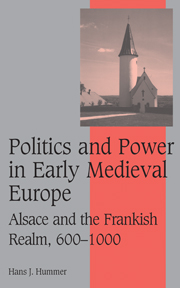Book contents
- Frontmatter
- Contents
- List of maps and tables
- Preface and acknowledgements
- List of abbreviations
- INTRODUCTION
- 1 THE LATE MEROVINGIAN ORDER
- 2 CONQUEST AND CONTINUITY
- 3 THE CAROLINGIANS AND ECCLESIASTICAL PROPERTY
- 4 REACTION AND RESISTANCE
- 5 THE POLITICS OF OLD GERMAN
- 6 IMPERIAL UNITY AND REGIONAL POWER
- 7 THE LATE CAROLINGIAN ORDER
- 8 THE TENTH-CENTURY TRANSFORMATION
- 9 CONCLUSIONS
- Appendix: Records of the dispute between Rodoin and Gebahart and the monastery of Weissenburg
- Bibliography
- Index
- Cambridge Studies in Medieval Life and Thought Fourth series
7 - THE LATE CAROLINGIAN ORDER
Published online by Cambridge University Press: 16 July 2009
- Frontmatter
- Contents
- List of maps and tables
- Preface and acknowledgements
- List of abbreviations
- INTRODUCTION
- 1 THE LATE MEROVINGIAN ORDER
- 2 CONQUEST AND CONTINUITY
- 3 THE CAROLINGIANS AND ECCLESIASTICAL PROPERTY
- 4 REACTION AND RESISTANCE
- 5 THE POLITICS OF OLD GERMAN
- 6 IMPERIAL UNITY AND REGIONAL POWER
- 7 THE LATE CAROLINGIAN ORDER
- 8 THE TENTH-CENTURY TRANSFORMATION
- 9 CONCLUSIONS
- Appendix: Records of the dispute between Rodoin and Gebahart and the monastery of Weissenburg
- Bibliography
- Index
- Cambridge Studies in Medieval Life and Thought Fourth series
Summary
During the late Carolingian period the relative power of kings, monasteries and families was subtly reconfigured. As the dust settled from the succession conflicts of the second third of the ninth century, many monasteries came under the direct domination of patron families. This situation contrasts markedly with the high Carolingian period, when monasteries attempted to establish a clearer hierarchy of ecclesiastical rights over family rights; and with the late Merovingian period, when the relationships between monasteries and families were essentially symmetrical. Aristocratic dominance was not brought about, as once alleged, by the putative impotence of late Carolingian kings, because royal authority always remained relevant to the aristocracy and because in the east Frankish kingdom, with the possible exception of the first two decades of the tenth century, royal power remained a potent force. In Alsace in particular, royal influence continued to circulate freely.
Upon the death of Louis the German (876), east Francia was partitioned into three kingdoms: Bavaria went to Carloman, the northern sector plus Lotharingia went to Louis the Younger, and the southwestern portion, namely Alsace and Alemannia, was apportioned to Charles the Fat. Charles was well-connected to the local aristocracy, having been married to Richgarda, daughter of Count Erchangar, whose family had been prominent in both Alsace and Alemannia at least since the latter years of Charlemagne's reign. In time-honoured tradition, Charles and his queen cultivated their position in Alsace with the organization of a new monastery at Andlau.
- Type
- Chapter
- Information
- Politics and Power in Early Medieval EuropeAlsace and the Frankish Realm, 600–1000, pp. 209 - 226Publisher: Cambridge University PressPrint publication year: 2006

